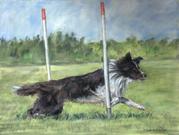Leuke kwestie over groentemixen 
 Ina, Misty en Aysa
Ina, Misty en Aysa  3 doggies
3 doggies

Nooit over nagedacht..., de enige reden waarom ik (sommige) groentes licht kook, is omdat ze dan makkelijker te pureren zijn met m'n staafmixer 
Als ik jou tekst goed lees, zou dus alle groente die wij voor ons zelf koken, voor de honden ook gekookt moeten worden.
Ik heb altijd begrepen dat er voor de verwerking verder geen verschil zit tussen gekookt of gepureerd, zolang de cellen maar kapot zijn, zodat de vitamines en mineralen verteerd kunnen worden..., verder heb ik nooit over groente nagedacht.
 Yin, Yang & ik
Yin, Yang & ik
 3 doggies
3 doggies


-factors depressing digestion or metabolic utilisation of proteins (protease inhibitors, lection, tannins, phytate)
-factors depressing the digestion of carbohydrates (alfa-amylases inhibitors, tannins)
-factors affecting the mineral availability for absorption (in small intestine) (phytate, oxalic acid)
-factors that alternate the immunesystem (antigenic proteins)
Er zullen nog veel meer voorbeelden zijn van voorbeelden, maar ik doe het even uit mijn hoofd en dit zijn de bekendste'

Door 'plant breeding' zit er al in veel planten (die dus rauw gegeten worden door mensen) minder naf's; gewoon door selectie dus. In andere plantsoorten zitten er nog wel naf's. Ook diegenen die wij dus rauw door de groentemix van onze 4voeters heen blenderen. Een heleboel naf's kun je dus deactiveren door je groenten te koken....
Ik kook mijn groenten dus altijd voor de honden en ik ben dus benieuwd naar de beweegredenen van degene die dit niet doen.... "
Bij welke groenten wordt er dan niet geselecteerd ('plant breeding')? Je zou dan toch verwachten dat het bij meest gangbare groenten gedaan wordt? Ervan uitgaande dat het zo is, hoe nadelig zouden de effecten überhaupt kunnen zijn op dat kleine percentage groenten wat velen (niet eens) dagelijks geven?
 ~ ~ ~ Mellow ~ ~ ~
~ ~ ~ Mellow ~ ~ ~  3 doggies
3 doggies

Mijn Engels is niet je van het, dus ik waag me nu even niet aan de Engelse tekst, sorry 
Ik heb ooit begrepen dat ongekookt en ongepureerd niet goed genoeg wordt opgenomen, ze pikken dan de voedingsstoffen er niet uit. Dus ik kocht wat groenten, sneed dat eerst heel fijn (met zo'n hak-ding), vervolgens in de blender, klein beetje yoghurt of karnemelk erbij en dat in porties in de vriezer.
Ze kreeg ook wel eens gewoon wat gekookte groenten die ik over had van ons eten (om die reden ben ik sinds haar komst zoutloos gaan koken).
En eigenlijk vond (en vind) ik dat veel makkelijker.
Nu haal ik dus gewoon wat groenten uit de pan voor ik er zout en (evt.) nootmuskaat op doe.
De ene keer is het maar 1 stukje, de andere keer een schep. Soms heb ik veel en kan ik haar nog 2 dagen wat groenten bij haar eten geven.
Ze krijgt ook wel eens rauwe worteltjes, gewoon van die snackworteltjes. Die kauwt ze wel goed fijn, want ik vind nooit een intacte wortel in d'r ontlasting. Ooit gaf ik haar een rauwe sperzieboon die er bij de eerstvolgende bout-beurt weer in zijn geheel uitkwam (zag er raar uit  )
)
Daarom gewoon af en toe een beetje groenten van ons. Lekker makkelijk 
 Roos,Jeff † en Waldo † en Mootje †
Roos,Jeff † en Waldo † en Mootje † 
 3 doggies
3 doggies

Ik heb begrepen dat naast het kapotmaken van de celwanden de hond ook enzymen/bacterien uit het lichaam van een planteneter nodig heeft om de voedingstoffen echt goed te kunnen opnemen uit groente.
Dus gefermenteerde groente doen de truuk het beste 
 P
P  3 doggies
3 doggies
Cosmic eet niet veel groente bij haar BARF, maar wel wat. Ik neem dan gekookte groente (restjes van mijzelf) die ik vervolgens nog pureer (als ik daar zin in heb). Maar de hoeveelheid groente die zij krijgt is nagenoeg te verwaarlozen.
 Goldendelerious
Goldendelerious  3 doggies
3 doggies

Ik vind je informatie erg onvolledig. Wat voor bron heb je gebruikt?
Ik ben in mijn dagelijkse leven voedingsdeskundige, dus ik zal proberen onbevooroordeeld te zijn in jouw topic en niet uitgebreid te reageren.
Er zijn diverse factoren voor een optimale biologische beschikbaarheid. Soms is het nuttig om bepaalde groentes licht te stomen of licht te koken om bijvoorbeeld een vitamine A verhoogd te krijgen. Vaak is het nuttiger om een behoorlijk deel van de dagelijkse voeding uit enzymrijke bestanddelen te laten bestaan, dus onbewerkt. Variatie in de voeding kan inhouden dat het nuttig is om voedingsmomenten in te delen naar zogenoemde 'food groups'. Mensen met bepaalde ziektes kunnen voor een optimale opname en vertering baat hebben bij zo'n dieet. Ik ga niet mee in jouw relaas om groentes te koken, omdat rauwe groentes opname van voedingsstoffen zouden belemmeren. Met name is dat het geval bij een overload aan bijv. soja en andere peulvruchten, kiemgroentes en granen. Bij een gevarieerd dieet voor honden en katten, waarbij het merendeel uit vlees/bot/orgaanvlees of prooidieren zal bestaan, zijn tekorten of toxiciteit die e-ven-tu-eel zouden kunnen ontstaan erg nihil.
Fruits, nuts, and vegetables in the daily diet have been strongly associated with reduced risk
for some forms of cancer, heart disease, stroke, and other chronic diseases (Goldberg, 2003;
Hyson, 2002; Prior and Cao, 2000; Produce for Better Health Foundation, 1999; Quebedeaux
and Bliss, 1988; Quebedeaux and Eisa, 1990; Southon, 2000; Tomas-Barberan and Espin, 2001;
Wargovich, 2000). Some components of fruits and vegetables (phytochemicals) are strong
antioxidants and function to modify the metabolic activation and detoxification/disposition of
carcinogens, or even influence processes that alter the course of the tumor cell (Wargovich,
2000). Although antioxidant capacity varies greatly among fruits and vegetables (Prior and Cao,
2000; Perkins-Veazie and Collins, 2001; Kalt, 2002) it is better to consume a variety of
commodities rather than limiting consumption to a few with the highest antioxidant capacity.
The USDA 2000 Dietary Guidelines (USDA, 2000) encourage consumers to: (1) enjoy five a
day, ie., eat at least 2 servings of fruits and at least 3 servings of vegetables each day, (2) choose
fresh, frozen, dried, or canned forms of a variety of colors and kinds, and (3) choose dark-green
leafy vegetables, orange fruits and vegetables, and cooked dry beans and peas often. In some
countries, consumers are encouraged to eat up to 10 servings of fruits and vegetables per day.
There is increasing evidence that consumption of whole foods is better than isolated food
components such as dietary supplements and nutraceuticals. For example, increased consumption
of carotenoid-rich fruits and vegetables was more effective than carotenoid dietary supplements
in increasing LDL oxidation resistance, lowering DNA damage, and inducing higher repair
activity in human volunteers who participated in a study conducted in France, Italy, Netherlands,
and Spain (Southon, 2000). In another study, adding antioxidant (vitamins A, C and E) dietary
supplements into the diet of cancer treatment patients, who were eating a balanced diet of fruits
and vegetables, negatively impacted their radio- and chemotherapies (Seifried et al, 2003). High
consumption of tomatoes and tomato products has been linked to reduced carcinogenesis,
particularly prostate cancer, and has been thought to be due to the presence of lycopene, which
gives red tomatoes their color (Giovannucci, 2002). However, use of tomato powder effectively
reduced prostate carcinogenesis in rats, while lycopene supplements, considered the primary
active ingredient of tomatoes, had no effect (Boileau et al., 2003). Similar comparative studies
are needed on other constituents of fruits and vegetables and on the bioavailability of nutrients
taken as dietary supplements or as foods that contain these nutrients.
Examples of the phytochemicals in fruits and vegetables that have established or proposed
positive effects on human health and their important sources are shown in Tables 1 and 2. Some
changes in these tables are likely as the results of additional studies on effects of phytochemicals
3
and their bioavailability on human health become available in the next few years. Meanwhile it is
important to evaluate the validity and dependability of the results of every study before reaching
conclusions for the benefit of consumers.
Bron: http://www.ba.ars.usda.gov/hb66/025nutrition.pdf
http://www.leefbewust.com/2011/artikelen/008.html
http://www.leefbewust.com/themas/fytinezuur_granen.html

Mij werd het verhaal opgehangen door mijn da en werd dus erg nieuwsgierig naar meer info  *op internet vond je er niet zoveel over*
*op internet vond je er niet zoveel over*
Mijn honden aten toch al met de pot mee qua groenten, dus voor mij maakte het niet zoveel uit, maar was toch nieuwsgierig. Want wat nu dus blijkt; van een 1-zijdige blik op de info houd ik niet 
 Denise; Nova & Vancha
Denise; Nova & Vancha  3 doggies
3 doggies

Ik volg mee, als beginnend barfer. Nova krijgt nu gewoon rauwe groenten uit de blender.
 Goldendelerious
Goldendelerious  3 doggies
3 doggies

 *op internet vond je er niet zoveel over*
*op internet vond je er niet zoveel over*Mijn honden aten toch al met de pot mee qua groenten, dus voor mij maakte het niet zoveel uit, maar was toch nieuwsgierig. Want wat nu dus blijkt; van een 1-zijdige blik op de info houd ik niet
 "
"Inderdaad erg eenzijdig. Wees blij dat jij je honden die veelzijdigheid kan bieden. Niet alles geloven, hoor. Laatste berichtje van mij. Dan houd ik me afzijdig.
Interestingly, the extrusion process is thought to lessen the biological inappropriateness of the grain content in dry pet food formulas. According to the Animal Nutrition Group’s report linked above:
One of the challenges when using cereals in canine diets is the presence of anti-nutritional factors that are harmful for dogs. Study on NAF in canine diets show that extrusion cooking inactivates NAF activity especially those of a proteinaceous structure (Purushotham et al., 2007).
I’ll discuss more about nutritionally active factors shortly.
Another starch-related fact mentioned in the report is that extrusion conditions and the type of starch used can affect glucose and insulin response in dogs after a meal of dry food.
Extruded rice causes a higher glucose and insulin response than other extruded starches like barley, corn, wheat and sorghum. Since rice is considered by many pet owners to be a healthier grain than others, this is good information for those of you who have a pet with diabetes or an overweight dog or cat at risk for the disease.
Inactivation of Nutritionally Active Factors
The ingredients used in dry pet food mixtures, in particular grain legumes, contain undesirable nutritionally active factors (NAFs) that interfere with digestion and absorption of nutrients.
An example of nutritionally active factors is trypsin inhibitors, also called protese inhibitors. These toxins are most often associated with soy products. Trypsin inhibitors are chemicals that reduce the availability of trypsin, an enzyme crucial for digestion.
The good news is the extrusion process used in the manufacture of dry pet food inactivates undesirable NAFs in the ingredient mixture. It also reduces the activity of naturally occurring toxins like allergens, glycoalkaloids and mycotoxins present in grains prior to extrusion. Unfortunately, the extrusion process doesn’t entirely eliminate the activity of these toxic substances. Mycotoxins are still a big risk in dry pet foods even after the manufacturing process is complete.
Since the presence of NAFs limits the amount of grain used in pet food ingredient mixes, if the extrusion process deactivates the NAFs, then the not-so-good news is that even higher percentages of grain could be added to dry food formulas. Grain is much cheaper than biologically appropriate ingredients like meat and vegetables.
Bron: http://healthypets.mercola.com/sites/healthypets/archive/2011/05/19/the-mainstream-pet-communitys-new-take-on-cat-and-dog-foods.aspx

- Zoeken op de HondenPage
-
Zoek je iets op de HondenPage ? Vul dan hier jouw zoekwoorden in ?

